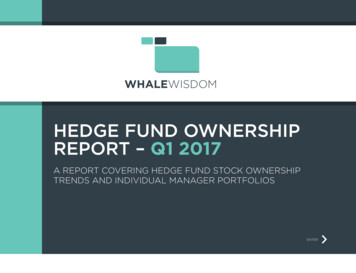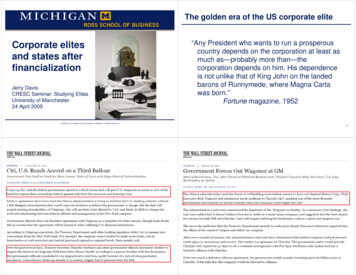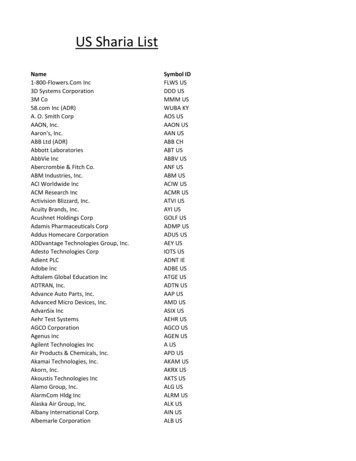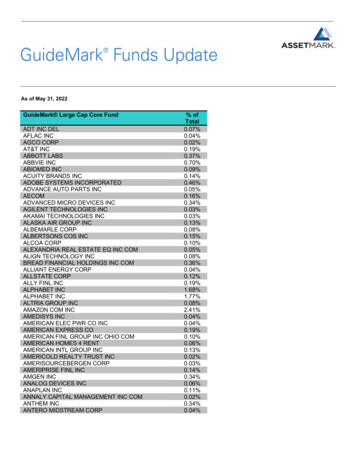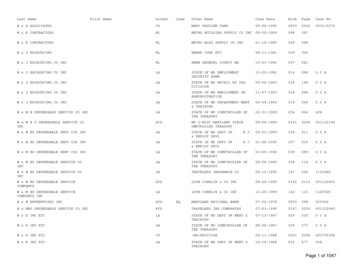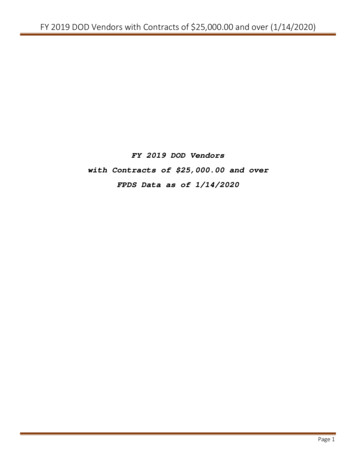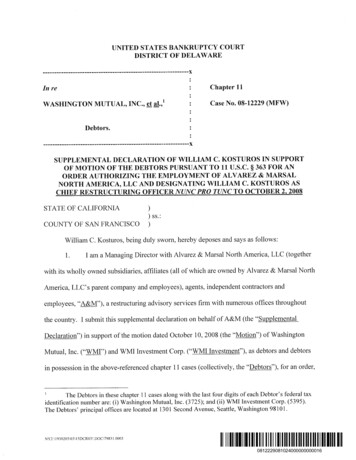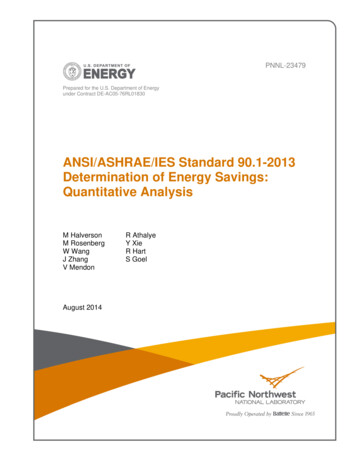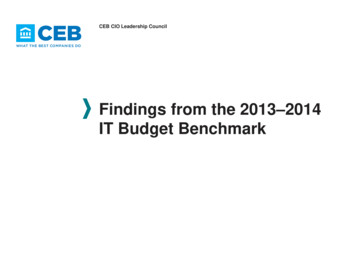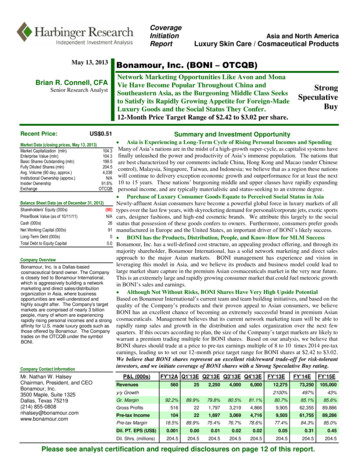
Transcription
CoverageInitiationReportMay 13, 2013Brian R. Connell, CFASenior Research AnalystRecent Price:Bonamour, Inc. (BONI – OTCQB)Network Marketing Opportunities Like Avon and MonaVie Have Become Popular Throughout China andSoutheastern Asia, as the Burgeoning Middle Class Seeksto Satisfy its Rapidly Growing Appetite for Foreign-MadeLuxury Goods and the Social Status They Confer.12-Month Price Target Range of 2.42 to 3.02 per share.US 0.51Market Data (closing prices, May 13, 2013)Market Capitalization (mln)104.3Enterprise Value (mln)104.3Basic Shares Outstanding (mln)199.5Fully Diluted Shares (mln)204.5Avg. Volume (90 day, approx.)4,038Institutional Ownership (approx.)N/AInsider Ownership91.6%ExchangeOTCQBBalance Sheet Data (as of December 31, 2012)Shareholders’ Equity (000s)Price/Book Value (as of 10/11/11)Cash (000s)Net Working Capital (000s)Long-Term Debt (000s)Total Debt to Equity Capital(98)N/A269100.0Company OverviewBonamour, Inc. is a Dallas-basedcosmaceutical brand owner. The Companyis closely tied to Bonamour International,which is aggressively building a networkmarketing and direct sales/distributionorganization in Asia, where businessopportunities are well-understood andhighly sought after. The Company's targetmarkets are comprised of nearly 3 billionpeople, many of whom are experiencingrapidly rising personal incomes and a strongaffinity for U.S. made luxury goods such asthose offered by Bonamour. The Companytrades on the OTCQB under the symbolBONI.Company Contact InformationMr. Nathan W. HalseyChairman, President, and CEOBonamour, Inc.3500 Maple, Suite 1325Dallas, Texas 75219(214) 855-0808nhalsey@bonamour.comwww.bonamour.comAsia and North AmericaLuxury Skin Care / Cosmaceutical ProductsStrongSpeculativeBuySummary and Investment Opportunity Asia is Experiencing a Long-Term Cycle of Rising Personal Incomes and SpendingMany of Asia’s nations are in the midst of a high-growth super-cycle, as capitalist systems havefinally unleashed the power and productivity of Asia’s immense population. The nations thatare best characterized by our comments include China, Hong Kong and Macao (under Chinesecontrol), Malaysia, Singapore, Taiwan, and Indonesia; we believe that as a region these nationswill continue to delivery exception economic growth and outperformance for at least the next10 to 15 years. These nations’ burgeoning middle and upper classes have rapidly expandingpersonal income, and are typically materialistic and status-seeking to an extreme degree. Purchase of Luxury Consumer Goods Equate to Perceived Social Status in AsiaNewly-affluent Asian consumers have become a powerful global force in luxury markets of alltypes over the last few years, with skyrocketing demand for personal/corporate jets, exotic sportscars, designer fashions, and high-end cosmetic brands. We attribute this largely to the socialstatus that possession of these goods confers to owners. Furthermore, consumers prefer goodsmanufactured in Europe and the United States, an important driver of BONI’s likely success. BONI has the Products, Distribution, People, and Know-How for MLM SuccessBonamour, Inc. has a well-defined cost structure, an appealing product offering, and through itsmajority shareholder, Bonamour International, has a solid network marketing and direct salesapproach to the major Asian markets. BONI management has experience and vision inleveraging this model in Asia, and we believe its products and business model could lead tolarge market share capture in the premium Asian cosmaceuticals market in the very near future.This is an extremely large and rapidly growing consumer market that could fuel meteoric growthin BONI’s sales and earnings. Although Not Without Risks, BONI Shares Have Very High Upside PotentialBased on Bonamour International’s current team and team building initiatives, and based on thequality of the Company’s products and their proven appeal to Asian consumers, we believeBONI has an excellent chance of becoming an extremely successful brand in premium Asiancosmaceuticals. Management believes that its current network marketing team will be able torapidly ramp sales and growth in the distribution and sales organization over the next fewquarters. If this occurs according to plan, the size of the Company’s target markets are likely towarrant a premium trading multiple for BONI shares. Based on our analysis, we believe thatBONI shares should trade at a price to pre-tax earnings multiple of 8 to 10 times 2014 pre-taxearnings, leading us to set our 12-month price target range for BONI shares at 2.42 to 3.02.We believe that BONI shares represent an excellent risk/reward trade-off for risk-tolerantinvestors, and we initiate coverage of BONI shares with a Strong Speculative Buy rating.P&L (000s)RevenuesFY'12A Q1'13E Q2'13E Q3'13E Q4'13EGross ProfitsPre-tax .6%516221,7973,2194,8669,90562,35589,886y/y GrowthGr. %Dil. PT. EPS (US )0.0010.000.010.020.020.050.310.45Dil. Shrs. Pre-tax MarginPlease see analyst certification and required disclosures on page 12 of this report.
Bonamour, Inc. (BONI – OTCQB)May 13, 2013Industry BackgroundIntroductionBonamour, Inc. (BONI - OTCQB) is a Dallas-based developer and brand owner of a high-end line of anti-agingskin care products often referred to as cosmaceuticals. The Company markets and distributes its products vianetwork marketing and direct sales through closely-affiliated Bonamour International, LLC into the fastesteconomically developing region of the world: China and Southeast Asia. The Company's target markets arecomprised of nearly three billion people, many of whom are experiencing rapidly rising personal incomes andhave a strong affinity for U.S. made luxury goods such as those offered by Bonamour.Bonamour Rejuvenating TrioBonamour SpokesmodelWe believe that a unique convergence of socioeconomic and political factors has created an unprecedentedopportunity for American-made products in this region, not only in the People's Republic of China, but also inseveral other rapidly developing nations and island states, such as Malaysia, Singapore, Indonesia, India, Taiwan,and China-controlled Hong Kong and Macau. Nations in this region have burgeoning middle classes and anexceptional rate of new millionaire creation; these newly-affluent and newly-wealthy consumers have a strongappetite for all foreign-made luxury goods, especially those manufactured in the United States. Such luxury goodsinclude vehicles such as sports cars and boats, luxury clothing, and other retail brands such as high-end cosmetics.Furthermore, large numbers of individuals in these regions have a pre-existing affinity for network marketingcompanies and the income they can create, and in fact myriad "downstream" organizations are already operatingthroughout Southeast Asia. We believe rapidly rising personal incomes, strong and growing demand forAmerican-made luxury products, and a pre-existing appetite for the network marketing business models has setthe stage for one or more large successes in the region. While Bonamour's eventual success remains to be seen,we believe BONI and its affiliate Bonamour International, LLC have the leadership, plan, products, vision, andnetwork marketing know-how to make it a likely contender in the region's massive network marketing / directsales & distribution product industry.The Network Marketing and Direct Sales IndustryThe global network marketing and direct sales industry has spawned several companies with over 1 billion insales, such as Amway, Avon, Herbalife, and more recently, MonaVie. To be considered a legitimate networkmarketing (rather than a pyramid) company by the U.S. Federal Trade Commission (FTC), the organization's paystructure must allow for compensation to be paid to each distributor on both the products he or she sells directly,and on the products sold by those he or she has recruited into the organization. Some network marketingcompanies also compensate their members for bringing in new recruits, although this practice is discouraged bythe FTC due to its similarity with (illegal) pyramid schemes' business model. As defined by the FTC, "legitimate"network marketing (or multi-level marketing) companies are those that generate the majority of sales revenuesfrom product sales (to members and non-members) rather than from new membership fees. There is quite a bitof gray area in this distinction, however, making network marketing companies and models difficult to uniformlycharacterize.Copyright Harbinger Research, LLC, 2013Page 2 of 13
Bonamour, Inc. (BONI – OTCQB)May 13, 2013Whatever the structural challenges and uncertainties of the network marketing industry may be, one thing iscertain: winning network marketing companies can generate amazing revenue and earnings growth. Whilethere are many losing ventures for each big success, the magnitude of the big successes can be quite staggering.Take for example MonaVie, a Utah-based company that began selling, bottling, and distributing MonaVie juicein early 2005. Despite the fact that the company's product offering consisted of nothing more than severalproprietary juice blends, it was able to scale from no sales in 2004 to a reported annualized level of over US 1billion by late 2009. Those who consume the product report a good taste and myriad health benefits, which incombination with the company's network marketing model were enough to fuel its meteoric rise over the last fewyears. We believe the MonaVie example is useful for elucidating how a well-architected network marketingbusiness with an in-demand product can rapidly succeed when things go well. Other highly successful networkmarketing businesses include Avon, Amway (US 9.2bil in 2010 sales), Mary Kay, Tupperware, Herbalife, andmany others.Demand Drivers - Luxury Consumer Goods, Southeast AsiaEconomic Growth: The last thirty years have brought extreme economic growth to all of the major nations ofAsia, including China, India, Malaysia, Indonesia, the Philippines, and Thailand, as well as to the islands ofSingapore, Hong Kong, Taiwan, and Macao (China). This economic growth has been nothing short of astounding,and has rapidly created expanding upper and middle classes in all of these countries. Given the enormouspopulations of these nations (2.98 billion people in the aggregate), this new consumer class is rapidly becoming aglobal economic force, driving sharp demand increases across multiple categories of goods and services both athome and abroad. The drivers of this economic growth are likely to persist into the foreseeable future, since thedeveloping economies of Asia, while highly populous, still have many years of high-growth to go before theirrespective GDPs per capita reach those of the developed nations.Population of Developing Countries and Regions, Southeast AsiaPopulation by Country, Major 00Thailand63,525,062Total Pop., Majors:2,943,855,362Population by Country or Region, IslandsTaiwan22,894,384Hong Kong7,067,800Singapore4,987,600Macau (China)543,656Total Pop., Islands:35,493,440Population Density Comparison, United States, India, and ChinaEastern United StatesCopyright Harbinger Research, LLC, 2013IndiaThe People's Republic ofChinaPage 3 of 13
Bonamour, Inc. (BONI – OTCQB)May 13, 2013Although most investors are aware that the major Asian economies have been outgrowing developed economiesfor many years now, and that they have large populations of economically-contributing individuals, few trulyunderstand what the purchasing power effect of this relatively higher growth has been. To illustrate this point, wehave prepared an annually-compounded measure of GDP per capita over the past thirty years, based on a commonUS measure set to unity at the beginning of 1960. As is evident in the graph below, the compounding effect ofhigh GDP growth rates over this timeframe has driven GDP per capita growth of as much as 4500% for somenations, whereas the United States’ and other developed nations’ GDP per capita has grown only a fraction asmuch over that same timeframe. As this trend continues into the future (which we believe it almost certainly will),the Pacific Rim will consume more and more of the luxury goods produced in the U.S. and abroad, boding verywell for those luxury consumer goods companies that derive their sales from the region.GDP Per-Capita Growth, 1981-2011, United States and Asia, by Country50.045.040.035.0China30.0SingaporeKorea, Rep.25.0Macao SAR, ChinaMalaysiaThailand20.0IndonesiaIndia15.0United States10.05.00.0* GDP per-capita of all nations set to unity (1.0) at 1960Copyright Harbinger Research, LLC, 2013Page 4 of 13
Bonamour, Inc. (BONI – OTCQB)May 13, 2013Consumer Spending Habits: Like many of the nouveau-riche in the United States, a high percentage of thenewly-wealthy in Asia choose to spend a significant percentage of their disposable income on luxury goods, manyof which are made outside of the consumers' nation of origin. In addition to being (in many cases) of superiorquality to domestically manufactured goods, Asian consumers largely believe that items manufactured in theUnited States (or in Europe) convey a certain caché that equates to perceived higher social status amongstpeers and superiors alike. This powerful association between possession of American-made luxury goods anda higher perceived social status provides a powerful incentive for Asian consumers to desire and pay premiumprices for American-made products, and we believe this trend will likely intensify significantly throughout therest of the decade.ConclusionThe demand for American-made luxury goods is strong and rapidly expanding in the developing economies ofSoutheast Asia, largely due to three persistent factors in the region: Large and Growing Populations. The relevant developing economies and nations of this region haveapproximately three billion in total population, which tends to be skewed downwards in average age andupwards in average productivity vs. the populations in the developed nations (U.S., Canada, Australia,Western Europe, Japan, and increasingly, South Korea). This population represents almost one-half of theglobal total and well over three times that of all of the world's developed nations combined. Rapid Economic Growth. On the National and Per-Capita Level, albeit from a low initial GDP per-capitabase level, these nations have been experiencing compound annual economic growth rates averaging as highas 10% for as many as 30 years, and still have average GDP per-capita levels well below those of developednations. We believe that these developing economies are likely to continue outgrowing their developedcounterparts nearly ad infinitum - in fact until no meaningful GDP per-capita gap remains between them. Thiswill entail another 20 to 30 years of economic outperformance from these nations; given the assumption ofgeopolitical stability over this timeframe, this should all but ensure that growth in demand for American-madeluxury goods in the region will remain extremely robust. Linkage of Social Status and Consumption of Premium American-made Products. In most social circlesthroughout the region, possession of American-made and European-made luxury goods confers a strong andimmediate gain in perceived social status. This "upward mobility" in status perception creates a very powerfulincentive for newly affluent and wealthy Asians to purchase these goods, even at premium price points.Because most of the "newly affluent" in Asia grew up in poverty, and in a culture where social status wasdirectly related perceived income and wealth, we believe the mindset of these Asian consumers will likelyremain as-is for at least another 20 years.It is the confluence and combined influence of these three factors that we find to be so compelling in terms of ourpositive outlook on these developing Asian economies, and the likely effect that these economies' strong continuedgrowth will have on the luxury goods industry through the world. With the exception of an unforeseeable andstrongly negative geopolitical event in the region (e.g. a major war), we believe that the continued outperformanceand strong growth of these economies is virtually assured; this view directly supports our thesis that the region'sgrowth in demand for luxury goods is in the early-to-mid stages of a long-term growth cycle that is likely to lastfor ten to twenty years or more. This will undoubtedly provide a strong economic "tailwind" to American productmanufacturers, distributors, and sales & marketing organizations operating through the region.Copyright Harbinger Research, LLC, 2013Page 5 of 13
Bonamour, Inc. (BONI – OTCQB)May 13, 2013Demand Drivers, Network Marketing Business Model AdoptionUnlike in the United States, where MLM businesses are typically regarded by most with a certain degree ofskepticism and lack of interest, MLM businesses have broad appeal to middle-class Asian consumers. We believethis is due to two primary factors: Asia's Not-Yet-Affluent Consumers Vastly Outnumber the Newly Affluent. While the developingeconomies of Asia boast the strongest new millionaire creation of any region, as measured by how many newmillionaires are created per year, the newly-affluent still represent only a small fraction of the total populationin these countries. The Proximity of New Wealth is Highly Motivating to Those Who Haven't Yet Achieved It. Many ofthose who are not yet affluent have become highly motivated to achieve said affluence as quickly as possible,largely as a result of the increase in social status and lifestyle they observe in others around them. Networkmarketing businesses offer these would-be-affluent consumers the opportunity to quickly move up the incomeand social status ladder in a very short time, if they are able to succeed with the network marketing opportunitythey choose.Because of these two interacting dynamics - the current asymmetry of wealth distribution in Asia, and themotivation stemming from consumers now believing that they too can become wealthy if given the rightopportunity - we are seeing high demand for network marketing businesses throughout the region. We believethis demand for network marketing opportunities is likely to persist or even intensify in the years to come, as moreand more Asians seek to attain the MLM success they have seen accomplished by others.Conclusion, Industry AnalysisOnly rarely do we see the demand-side for a category-specific market be as strong as it is (and should remain) forluxury goods in the developing Asian economies. Furthermore, the social factors in the region virtually guaranteethat in the aggregate American and European manufacturers of luxury goods will experience very strong andgrowing demand from this region for the foreseeable future. This suggests that Bonamour is entering severalmarkets with very favorable market fundamentals, namely robust and growing unit-volume demand and lowdemand-related price elasticity (i.e. persistence of high consumer demand despite relatively high prices). A priori,these factors should allow any competent manufacturer to earn exceptional gross margins on high and growingsales volumes - but if and only if it can overcome the challenge of developing a premium, highly-sought-afterbrand in each relevant market and product category. In our opinion, a properly executed network marketing anddistribution plan is rather uniquely suited to helping surmount this challenge, as network marketing businesses(e.g. MonaVie) have proven capable of simultaneously and deeply penetrating multiple large markets in parallel.While it remains to be seen if Bonamour will be successful in leveraging its managements' experience, top-qualityproducts, and network marketing experience to create a big success in Southeast Asian markets, we believe itsultimate success is a distinct possibility and perhaps even a probability.Copyright Harbinger Research, LLC, 2013Page 6 of 13
Bonamour, Inc. (BONI – OTCQB)May 13, 2013Company AnalysisCompany DescriptionBonamour Inc. (BONI) is a Dallas-based cosmaceutical product company and brand owner with a focus onnetwork marketing and sales/distribution through a related entity (Bonamour International). The Company’sproducts include a rejuvenating facial cleanser, a hydration product, and an eye skin repair ointment, and are basedon its own proprietary formulations. Unlike companies that rely on traditional marketing and advertising togenerate sales and brand awareness, Bonamour has built its business model on Asia-focused network marketing.Similar to recent billion-dollar successes such as MonaVie, Bonamour International employs a system that enablesits business partners to generate both current referral commissions and permanent residual income from productsales. Although Bonamour, Inc. (BONI) is a separate company, Bonamour International is the Company’s largestand controlling shareholder, and the two companies share the same chief executive. Furthermore, we expect thatthe vast majority of Bonamour, Inc.’s sales will be driven by Bonamour International’s success at building a largeand effective network marketing distribution channel is Asia, making its success and the success of the Companyvirtually one and the same.Bonamour International is in the preliminary phase of a major network marketing push in Southeast Asia, a regionwhere network marketing businesses are both very popular and well-understood. Given this region's affinity forforeign-made luxury goods and rapidly rising GDP per capita, and given the high-quality product formulationsowned by Bonamour, we believe the Company's strategy could be a big winner in several highly populous nations,such as China (including Hong Kong and Macao), Malaysia, Singapore, Indonesia, and Thailand. The Companytrades on the OTCQB under the symbol BONI.Corporate StructureBonamour, Inc. is the creator and brand owner of all products marketed under the Bonamour brand; its largest(and majority) shareholder is an affiliated domestic LLC, Bonamour International, which is wholly-owned byBonamour executives and stakeholders. This LLC is responsible for building out the network marketing anddistribution organization that is ultimately responsible for almost all sales of Bonamour products, although it isnot part of Bonamour and its financial results are accounted for separately. This allows Bonamour to act solelyas manufacturer and brand owner, and gives Bonamour a known per-item price point and a much simpler andcleaner business model. We believe this allows us to more precisely forecast the Company's likely costs andbusiness results, given our assumptions about future product sales.Products and Product TechnologyThe Company’s primary product offering is its Rejuvenating Trio kit, which consists of a cleanser (KLENZ), ahydration product (HI-DRAT), and a rejuvenating cream for skin around the eyes (KE-REKT). This product kitcomes in a single, premium package that contains all three products and a Bonamour certificate of productauthenticity.Copyright Harbinger Research, LLC, 2013Page 7 of 13
Bonamour, Inc. (BONI – OTCQB)May 13, 2013In addition, the Company offers a moisturizing mineral mist product (AKTE-VAT) that is “is specially formulatedto purify the skin and stimulate enzymatic activity to help increase the fibroblast production of pre-collagen.”The Company plans to periodically introduce new products for sales through Bonamour International andpotentially through white-label wholesale customers.Bonamour’s technology is based on collagen replenishment chemistry and biology, and on antioxidantformulations. From a scientific perspective, we do not have complete faith in orally-administered or topicallyadministered antioxidants, as they are highly unlikely to reach the site of the mitochondrial DNA “danger zone”(age-related damage is caused by free-radicals, such as O3) that is widely believed to be responsible for aging.However, many consumer products containing antioxidants have been extremely successful in the market (suchas MonaVie), so from a business perspective our scientific viewpoint pertaining to antioxidant effectiveness islargely irrelevant. Antioxidants sell and sell well, and we believe that the Company’s products are likely to bewell received by the market.Bonamour’s products also embody a combinations of vitamins, amino acids (which combine to form peptides),and peptides (which combine to form proteins) that are derived at least in part from plant stem cells. The Companyrefers to this as “Active Plant Stem Cell Technology” and believes that its formulations help preserve the youthfullook and vitality of the skin, and help the skin to generate more collagen, a compound known to increase skin’selasticity. Company testimonials confirm the efficaciousness of its products, as do the doctors associated with theCompany.The Company’s current products include:KLENZThis is a paraben-free rejuvenating cleanser that removes excess oil, makeup, and dead skin, leaving the skin softand moist. Note that parabens are a class of chemicals widely used by cosmetic and pharmaceutical companiesas preservatives that have also been found in breast cancer tumors, making their use increasingly controversial.HI-DRATThis product is based on the Company’s proprietary blend of ingredients and is formulated with its stem celltechnology to promote collagen production and protect cells from free radical damage. This hydrating treatmentis designed for use on facial and other sensitive skin areas.KE-REKTThe Company’s anti-aging eye cream, KE-REKT is designed to firm skin around the eyes while also minimizingage-related wrinkles. Its formulation includes vitamin A (important for the immune system and maintaining goodvision) and a proprietary blend of peptides, as well as caffeine, vitamin K, argan (tree extract from Morocco), andarnica (a floral extract from western North America).AKTE-VATThe Company’s most recently developed product, this mineral mist is designed to stimulate enzymatic activity tohelp increase fibroblast production of pre-collagen compounds. Fibroblasts are a type of cell that synthesize theextracellular matrix and collagen, of which animal tissues’ structural framework is comprised. Collagen inparticular has a key role in wound healing, making increased collagen production a highly desirable effect of skinrestoration and moistening products.Overall, we view the Bonamour product offering as being highly competitive with other successful products,based on the Company’s technology and on the attractiveness of its product packaging. Both of these aspects ofthe Company’s offering are likely to generate the impression of an exclusive, premium brand in the minds ofconsumers, which we view as one of the most important determinants of success for the Company. This isespecially true in the Asian markets where “all things American” are highly desirable and worthy of premiumpricing.Copyright Harbinger Research, LLC, 2013Page 8 of 13
Bonamour, Inc. (BONI – OTCQB)May 13, 2013Business ModelThe Company employs a simple and straightforward business model. It uses a local contract manufacturer toproduce and package its products, and it then sells those products to Bonamour International (at a fixed price pointof 250 per unit, at 90% gross margins), and potentially in the future to other product distributors under a “whitelabel” arrangement. In the United States, the Company does plan to market and sell its products through doctor’soffices and health spas, but does not plan to sell them online or through other retail channels.Bonamour InternationalAs the Company’s primary customer, the strategy of Bonamour International is particularly relevant for investorsin BONI; this company’s web address is: www.bonamour.com.Bonamour International is a network marketing and distribution company (e.g. Avon, MonaVie, and Mary KayCosmetics) that is focused on the Asian markets. According to management, Bonamour Intl. already has severalkey network marketing professionals selling the BONI product and business opportunity in Asian markets,specifically in Hong Kong and Macau, which give it access to the mainland China market as well. Given thenature of the Asian markets and their affinity for “hot” network marketing businesses and products, we expectthat management will be able to quickly parlay these initial beachheads in Asia into a rapidly growing brandsuccess.Target MarketsThe Company is targeting mainland China via Hong Kong and Macao staging points, and most other keyeconomies of Southeast Asia, including Malaysia, Indonesia, Thailand, Singapore, as well as the local economiesof Hong Kong and Macao themselves. As shown in the financial models, management believes that sales fromthis region will rapidly grow to a monthly level of US 3M – US 5M on their way to a more normalized monthlylevel of US 8M – US 10M. In the Future, the Company also plans to target India, and select spa and medicaloffices in the United States.LeadershipNathan W. Halsey, President and Chief Executive Officer, Bonamour, Inc. and Bonamour International, LLCMr. Halsey began his career as a management and strategy consultant for Ernst & Young, LLP. In this capacity,Mr. Halsey provided transformation advisory services to telecommunications companies. Mr. Halsey’s clientsincluded businesses that ranged in size from startups to Fortune 500 companies such as AT&T. In 2003, Mr.Halsey founded NWH Management, LLC, a holding and investment company with a focus on energy explorationand commercial real estate development. Between 2003 and 2008, Mr. H
exceptional rate of new millionaire creation; these newly-affluent and newly-wealthy consumers have a strong appetite for all foreign-made luxury goods, especially those manufactured in the United States. Such luxury goods include vehicles such as sports cars and boats, luxury clothing, and other retail brands such as high-end cosmetics.
